Instantaneous water heater per shower: how to get a reliable
Installing a running electric water heater on a shower or tap in the kitchen allows you to quickly solve the problem of disconnecting hot water. Such devices work fast enough, and therefore we will not have to wait to wash the dishes or take a shower after a hot day.
However, the popularity of flow heating plants has a downside: not all models on the market can boast of quality and reliability. That is why the choice of such products should be approached as responsibly as possible.
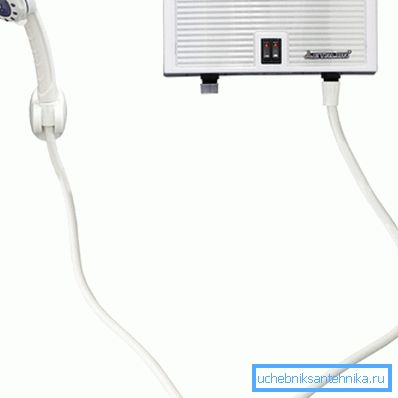
Operating principle
As a rule, for private houses, as well as for apartments, in which hot water switches off frequently, the owners purchase heating devices. The installation of such a device provides a certain level of autonomy: wash, take a shower, wash dishes, etc. possible at any time.
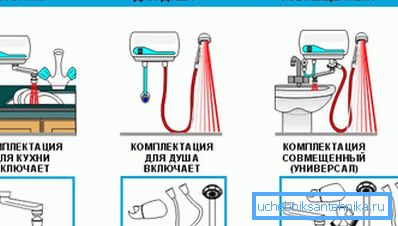
No less popular are storage type heaters. Their design provides for the presence of a sufficiently large (from 50 to 100 or more liters) capacity, inside which is located the heating element. During operation of the device, the entire volume is heated at once, respectively, and it takes a lot of time.
Alternative storage device is a flow type water heater:
- Such systems are either not equipped with a tank at all, or are equipped with small water tanks, which are, in essence, just an extension of the pipeline.
- Inside the device there is a rather powerful (3.5 - 5 kW and more) heating element. The transfer of heat from the heater to the water occurs when the fluid moves through the pipes and takes only a few seconds.
Depending on what type of fuel is used to operate the device, the heaters are divided into:
- Electric
- Gas
- Fuel oil
- Solid fuel
Note! The last two types are quite rare, since the combustion of liquid and solid fuels cannot provide a sufficient heating rate. Most often, such structures are used in large-scale industrial systems.
Varieties of devices
Electric
The flowing electric water heater on the crane and a shower represents rather compact device.
Such devices are acquired not only as main, but also as backup systems that are used only a few weeks a year for the duration of the hot water shutdown.
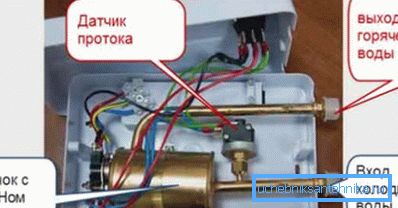
- The case of electric water heaters are most often made of plastic. Choosing such a device, you need to pay attention to the quality of the polymer: cheap models are often equipped with housings made of tough enough and fragile plastic, which quickly loses its strength, and therefore it cracks under any sufficiently strong impact.
- Inside the tube passes (often curved to increase the heat transfer area). The heat exchanger of a heating element joins a pipe. The design of this site can be very different, but in any case, design these details in such a way as to ensure minimal heat loss and protect the case from overheating.

- The heating element itself is connected to the electrical network. Moreover, if you plan to do all the work with your own hands, you should arrange the junction with the shield using a separate RCD (automatic) in order to avoid a short circuit during an overload.
Note! Before you choose an electric heater as the main device, consider whether the home power grid will withstand the load. If the wiring in your apartment was laid without calculation for the connection of the electric stove, then the maximum allowable heater power is 8 kW.
If the possibility of installing an electric stove project provided for, then the wires in the walls laid more reliable, and you can purchase a powerful machine.
- Also in the package of such systems must include a thermostat and fuse. The first component protects us from overheating, minimizing the risk of getting a stream of boiling water from the shower, and the second - from short circuit and electric shock.

Gas
A gas-powered device can also heat the water that passes through it, and it does this quite effectively.
Features of gas heaters are as follows:
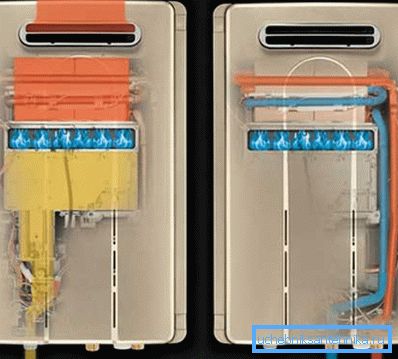
- The body can be made of both plastic and metal - the risk of closure is minimized here, so you can safely acquire more reliable metal structures.
- Inside there is a transport pipe with a heat exchanger, as well as a burner to which a pipe or flexible gas hose is supplied.
- Depending on the model, the burner can be either the simplest (operating in one mode) or modulation.
- Modulation burners are more convenient and economical: they operate under the control of a thermostat and therefore allow you to maintain a constant water temperature, regardless of the temperature of the source fluid entering the heater.
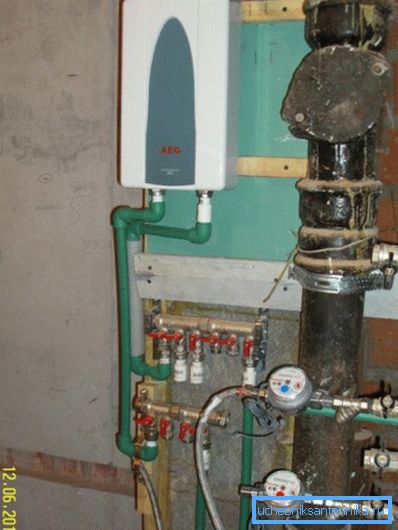
- If earlier constructions with a constantly burning igniter were used for this purpose, today almost all models on the market are equipped with electric ignition. This is quite convenient, since you can turn on the system by pressing a single button.
The undeniable advantage of such installations is quite high power. If you need a gas instantaneous water heater for a shower in the country, then a 16-20 kW appliance is enough, while for a home or apartment with a bath and hot water in the kitchen you can find devices of 25-30 kW.
The choice of design
Electrician or gas?
In this section, we will describe how to choose a instantaneous water heater for a shower. It will be much easier to understand this issue if you analyze the pros and cons of gas and electric models:
| Device type | Merits | disadvantages |
| Gas |
|
|
| Electrician |
|
|

Summarizing, we can say that for a city apartment as a backup system it is best to install an electrical device. It is also suitable for giving, especially if we do not plan to live outside the city for a long time.
But in a private house it is worthwhile to install a gas water heater: yes, at the first stage, the costs will be higher, but then all the invested funds will pay for themselves at the expense of cheaper gas.
Pressure and pressureless modifications
Another nuance that affects the choice of a flow heater for a shower or faucet is how much pressure it works.
By this parameter, all devices are divided into non-pressure and pressure:
- Non-pressure apparatus designed to heat the water entering the pipe under pressure, which is equal to or less than atmospheric. A stop valve is installed at the inlet, while at the exit there should be no obstacles to the free flow of water: otherwise, the system will simply fail.

- The range of free-flow units is very limited. Most often, according to this scheme, do portable shower heaters to give. They are equipped with separate watering cans with water dividers, so they are rarely used in apartments.
Note! The power of non-pressure devices - from 3.5 to 8 kW - allows you to use them either for washing dishes or for heating water for a summer shower. However, in the second case, the water will not hot, but only slightly warm. On the other hand, if the water flow rate slows down dramatically, then you risk getting a thin stream of boiling water.
- Pressure devices are built into the water supply system of a house or apartment, since their design withstands nominal 4 - 6 atmospheres without problems. They are not completed with additional nozzles, so you can use your existing faucets or shower heads.
- Obviously, much greater comfort is provided when using pressurized water heaters. However, they cost much more, and the power consumption due to their impressive power is much higher than that of non-pressure ones.
Installation technology flow heater
Wizards who have not previously encountered such devices often ask how to install a flow heater. In fact, this task is quite simple, so here we will give a complete algorithm for mounting a pressure model with power supply.
Note! As we noted above, the connection of the device to the gas pipeline should be entrusted to specialists.
The instruction provides for the following sequence of work:
- First, choose a place to secure the device. Most often they are mounted either in the bathroom or under the sink in the kitchen. In any case, it is desirable that the installation point is in the immediate vicinity of the water pipes.
- Next, we form taps from the supply with cold water to attach to the heater. It is undesirable to use flexible hoses, as they wear out rather quickly, especially in the mode of temperature drops.
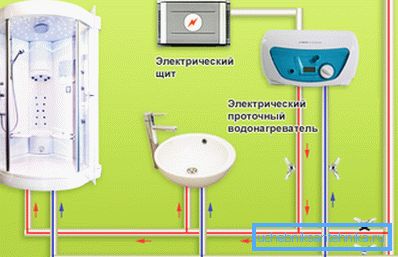
- Then run the cable to connect the system. Of course, you can simply plug the device into an outlet, but if you use a sufficiently powerful model (over 3.5 kW), then you will have to build a separate line of durable wire laid in the gate or cable-channel protected from water. The wire is connected to the distribution panel through the RCD.
Useful: the wire cross-section is selected at the rate of 1 mm2 by 8 amps. The current is easy to calculate by dividing the rated power of the device by the voltage of its supply.
- After that, install the structure on the wall, fixing it with hooks or anchors. In some cases, the heater may be mounted on the back wall of the kitchen bollard, but you shouldn’t do that: the body may heat up sufficiently during operation, resulting in deformation of the wood or MDF, and in the event of a short circuit it may cause a fire.
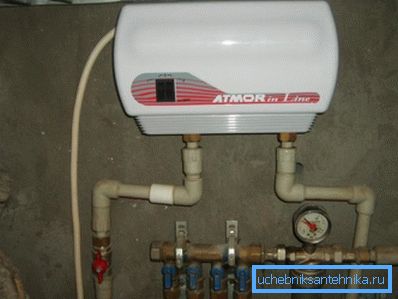
- We connect the input device to the pipe with cold water, and the output - to the pipe going to the mixer. Carefully monitor the tightness of the connection node.
After completing this work, open the water and check for leaks. If the droplets do not protrude anywhere, you can turn on the power supply and adjust the optimum temperature of the water that the device will issue.
Conclusion
The instantaneous water heater for a shower stall or a tap in the kitchen can be effective only if you choose a modification that meets the basic needs and conditions in your home.
You can learn more about the devices of this type by studying the video in this article.